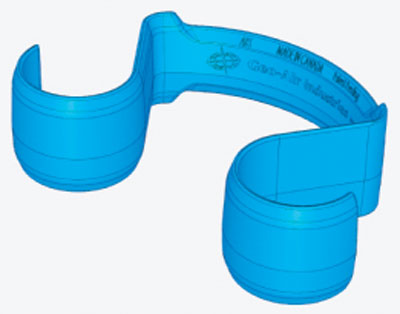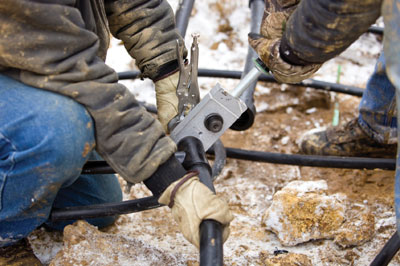
Products
Products
It’s all in the details!
The complexity of a geothermal ground loop installation.
April 17, 2012 By Benjamin HÉnault
Innovation means new challenges and new methods of working.
Innovation means new challenges and new methods of working. This reality is everywhere, but it is particularly true for an industry that has not reached maturity, which is the case for the GLSHP (Ground Loop Source Heat Pump) industry.
 |
|
| Thermally enhanced grout and pipe spacers are necessary to reduce borehole thermal resistance. Advertisement
|
At what price does it become interesting to innovate? Ground loop installers live this rude reality each day and decide whether to innovate or not. Innovation requires an investment of time and money and increase risk. Think about grout mixture and pipes spacers. These practices are by no means recent, yet not all installers offer them. Why is that? These practices might seem like standard procedures, but in reality they are not.
Normally, the contractor hires a loop installer that is equipped and trained in order to execute the work as required by the designer. The installer must mention his or her issues to the designer and they must fix the problem together. Surprising as it sounds, bad installations are often the result of poor or difficult communications between the installer and designer in their attempts to resolve issues. Some installers prefer to stay quiet and do the work as they know it, without consideration for designers’ plans or specifications. The rationale is that nobody will know what is in the borehole once the backfill material is back in place. Well, guess what? This attitude presents a huge problem for the industry.
Thermally enhanced grout, pipe spacers and their impact
Thermally enhanced grout and pipe spacers are necessary to reduce borehole thermal resistance. More specifically, they provide for a better heat exchange between the borehole and the surrounding geology. This means that the borehole can be shorter than a conventional borehole despite the same geological conditions. The difference in price between all these parameters will help to evaluate which configurations are best suited for a geothermal system. If the installer can do all the configurations, he or she gives many quotations to the designer. These price differences will help the designer evaluate which option is most profitable for a specific system. For example, thermally enhanced grout is not always necessary in order to significantly reduce the length of a ground loop heat exchanger. The grout should be used when the geological conditions of the surrounding medium are thermally bad. Another way to think of it: The borehole material is the first layer; and can act as a shield, or highway. The second layer is the geological medium. It is not necessary to have a highway of a few inches if the second layer is also a shield. This means that the more your soil is thermally conductive, the more the grout mix needs to be.
Grout mixture
At first glance, the grout mixture recipe comprises three or four ingredients, like a simple cake mix. However, a job site is not a kitchen, and the volume that requires mixing is considerable. Manufacturers’ recommendations are extremely precise because the exact ratio of each component will affect the properties of the grout. The water volume variation of 0.1 US gallon on 27 US gallons of slurry mix will affect the viscosity of the fluid. Using too little water will render the fluid unpumpable. This does not happen if too little water has been added; the problem arises when there is too much water in the mixture. This leads to the question: what will happen with the properties of the grout? How does one control that? The Canadian GeoExchange Coalition (CGC), Canmet Energy (NRCan), l’École Polytechnique de Montréal and GeoEnergie inc. are collaborating on this question in search of answers.
 |
|
| A key to profitability lies in constant improvement of skilled labour.
|
As stated in CSA C448, Design and Installation of Earth Energy Systems, the grout must be injected from the bottom to the top of the borehole through a tremie pipe. This operation means that the entire borehole must be grouted with a bentonite mixture, and not only a bentonite plug. Again, is it really the solution for the efficiency of geothermal ground loop systems?
The answer is NO. For example, saturated quartz sand is more conductive than a thermally enhanced grout with a bentonite base. The issue with quartz sand is that it is too permeable for the protection of the environment and is not very thermally conductive without water saturation. In some cases, using quartz sand in the bottom section of the borehole and bentonite grout mixture on the upper section would be better and acceptable enough for the environment. Each project is a case-by-case scenario. For a big project, the way to determine the best solution would be to involve a hydrogeologist and obtain a consultation report from a qualified professional. Depending on the lithography and the aquifer types (level, quality, dimensions, hydraulic gradient, hydraulic conductivity, etc.) observed in the test well(s) and any available information on the region, the hydrogeologist can recommend different types of grout at different levels in the boreholes.
These kinds of specifications present an additional challenge to the loop installer. He or she needs to use different machineries depending on the different operations required for the ground loop construction. And it might be different each time. More effective work will lead to a more profitable project for everyone. The key lies in constant improvement of skilled labour. This includes managerial thinking, constant training updates and practice.
Pipe spacers
Pipe spacers are used to maintain the pipe against the borehole wall. Several theoretical and empirical experiments demonstrate the benefit of using them by reducing the thermal resistance of the borehole when they are correctly installed.
Complaints about this gadget are generally associated with a bad method of loop insertion. To install them may require modification on loop reel and heavier ballast attached to a U-Bend. Those considerations are not always welcomed by every installer because they change their work habits. Normally, if you follow the manufacturers’ recommendations of pipe spacers, they will become easier to install. However, a borehole lithology described by crumbled rock demands particular attention because the HDPE U-Bend pipe insertion could be difficult or impossible. This may occur with or without pipe
spacers and the crumbling risk level should have been determined during the prefeasibility study. A vertical ground loop heat exchanger is not always the best solution, which is why a geological condition survey is critical for loop efficiency.
Innovations
Reducing the overall cost of a geothermal system is the purpose of these two specifications. We have many others possibilities: pipe material, number of pipes per borehole, pipe thickness, pipe geometry, borehole diameter, etc. These detail considerations are elements that will bring the industry to higher standards. Are you ready for it?
Benjamin Hénault is a professional engineer. Since graduating from École de technologie supérieure, he has worked as the technical advisor at Canadian GeoExchange Coalition and is studying geothermal research for his masters degree at École Polytechnique de Montréal.
Print this page